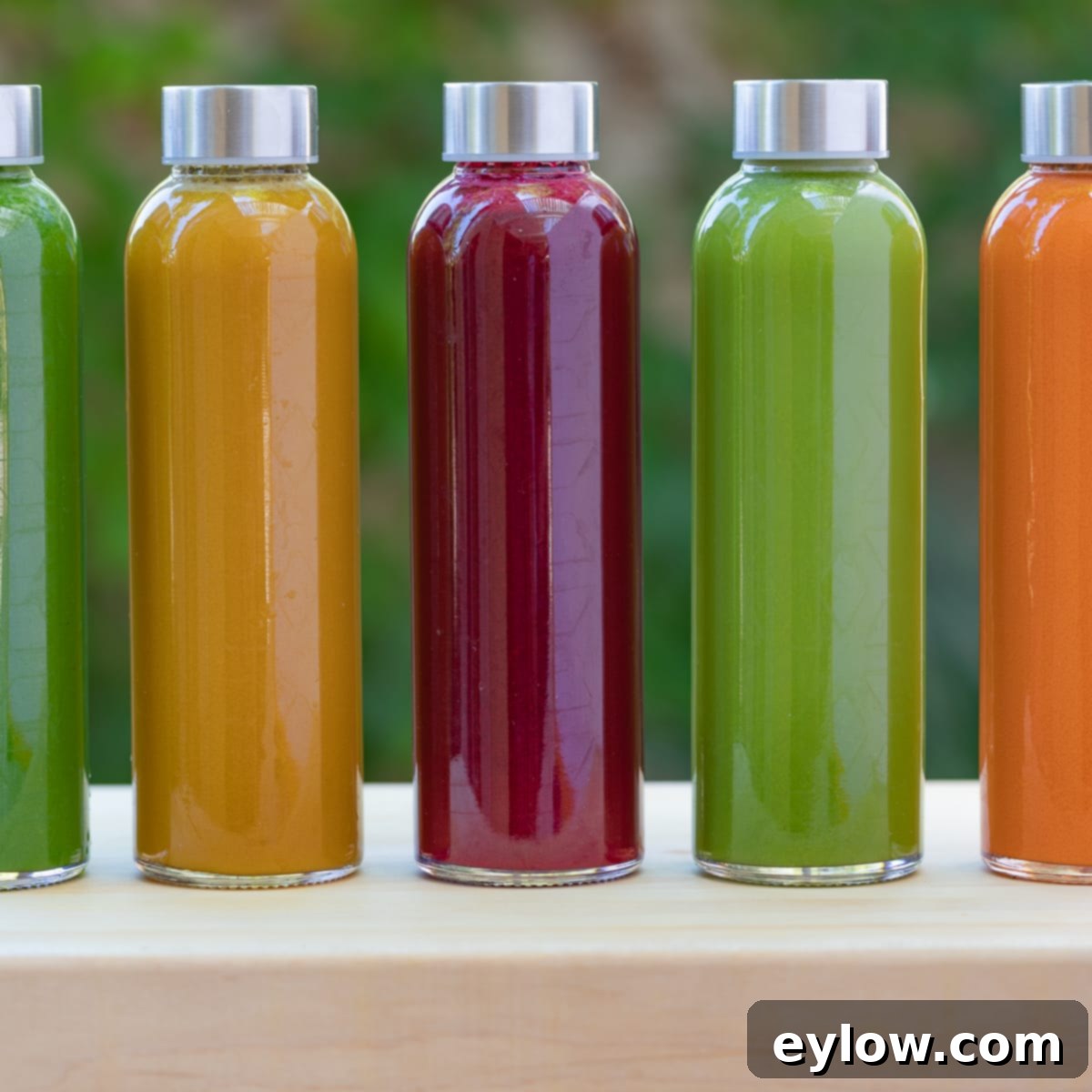The Complete Guide to Vegetable Juicing: Unlock Health, Boost Energy, and Master Your Juicer
Juicing with vegetables offers a powerful and efficient way to infuse your diet with essential nutrients, promoting overall well-being. Incorporating just one fresh, vibrant vegetable juice into your daily routine can lead to increased energy levels, enhanced mental clarity and focus, a robust immune system, and a significant boost in nutritional intake. This comprehensive guide will walk you through everything you need to know about making the best healthy juices at home, from understanding the benefits to choosing the right equipment and delicious recipes.
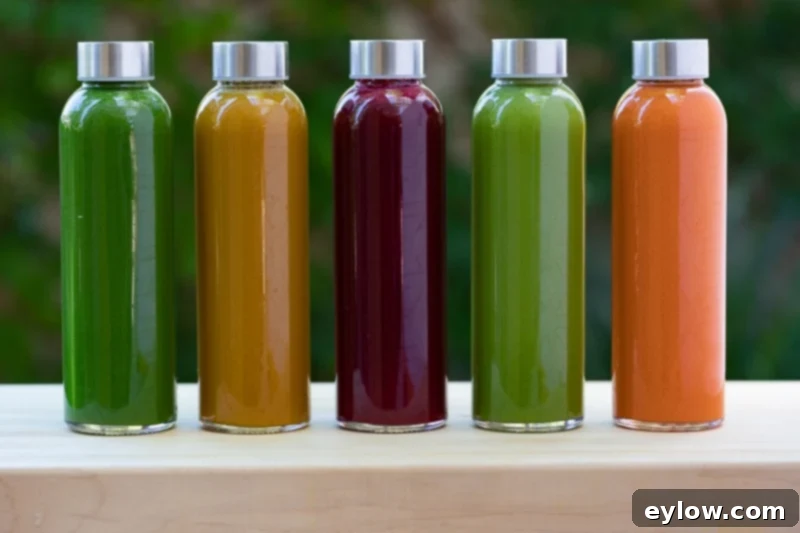
When you embark on juicing at home, you’re creating fresh, cold-pressed juice that is unpasteurized and made from whole vegetables and low-sugar fruits. This is the real deal, packed with living nutrients that store-bought, processed juices simply can’t match. Making your own juice ensures you consume it at its peak freshness, maximizing its incredible health benefits.
The Enduring Popularity of Juicing
In recent years, the wellness landscape has seen a remarkable resurgence in the popularity of juicing. With juice bars becoming ubiquitous and social media platforms brimming with vibrant juice creations, it’s clear that the health movement has embraced vegetable juicing once again. While its modern prominence might seem new, the concept of juicing is actually deeply rooted in history. The therapeutic use of raw fruit and vegetable juices dates back to the 1920s and 1930s. However, it was figures like Jay Kordich, “the Juiceman,” a true pioneer in natural health, who cemented juicing’s place in contemporary wellness. Kordich, often hailed as the modern-day Father of Juicing, famously attributed his recovery from cancer to a juicing regimen, dedicating his life to educating others on its profound benefits. This rich history, combined with compelling personal testimonials and emerging scientific research, underscores the amazing potential health benefits you can experience when you make juicing a daily habit.
Why Incorporate Daily Juicing?
The core philosophy behind daily juicing is simple: to *add* a powerful nutritional boost to your existing diet, not to replace it. A daily juice seamlessly integrates into your routine without requiring you to give anything up. It’s crucial to understand that juicing is a supplement to, rather than a replacement for, a diet rich in whole fruits, vegetables, and leafy greens. Whole foods provide essential dietary fiber that juices do not. However, juicing offers unique advantages that complement your fiber intake.
Incorporating a single juice each day is a sustainable and approachable habit, far easier to maintain than strict juice fasts or intense juice cleanses. This consistent approach delivers ongoing, long-term health benefits, making it a cornerstone of a proactive wellness strategy.
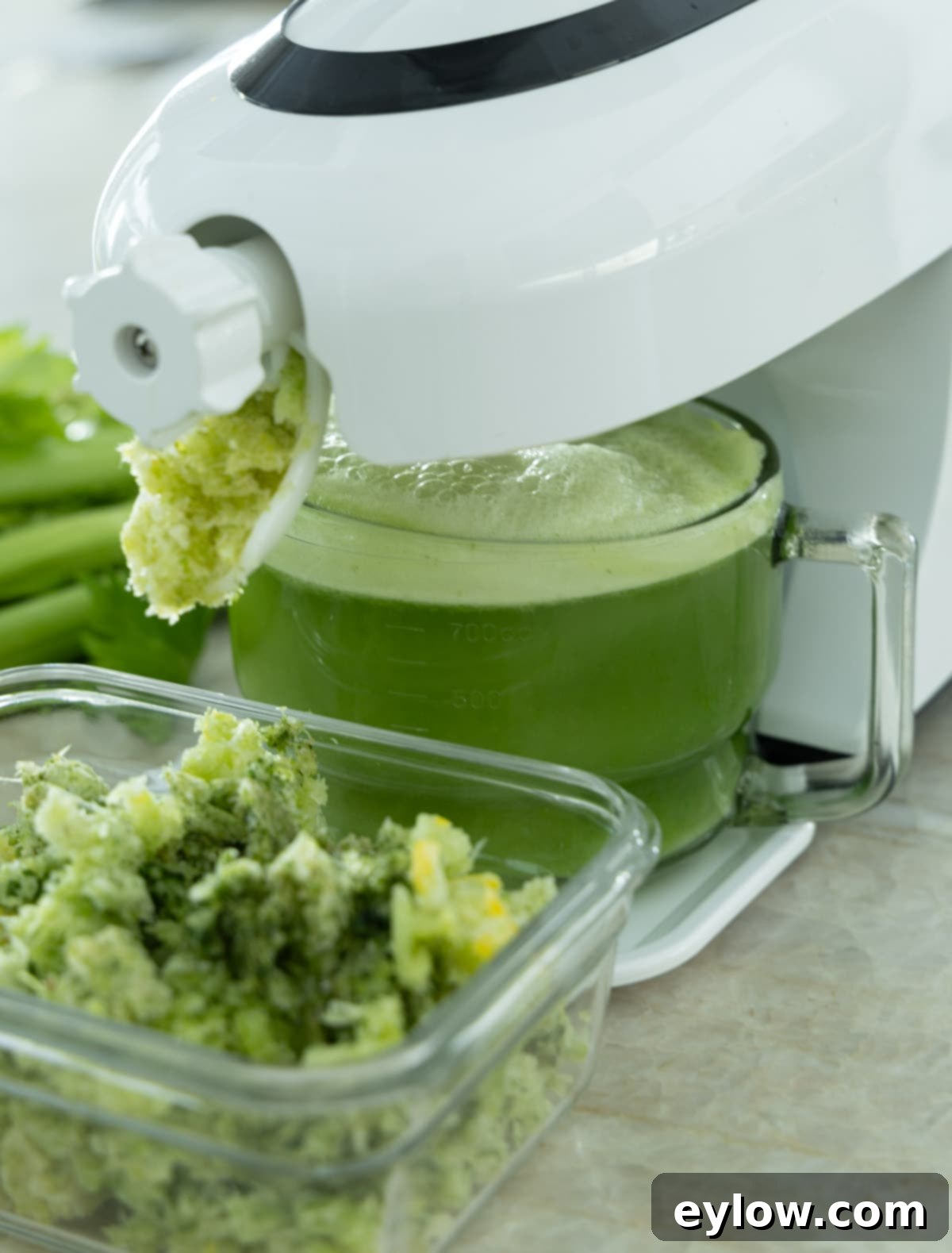
Chef’s Tip: Why Green Juice? The answer is simple: chlorophyll. This beautiful green plant pigment is vital for photosynthesis, converting light into energy. When you drink green juice, you’re consuming this powerful compound, which offers a myriad of health benefits. Research highlights the many health benefits of chlorophyll, including its potent antioxidant properties and its ability to act as a natural detoxifier. Just observe the vibrant color of a freshly made green juice – it’s a clear indicator of its concentrated life force!
Expected Health Benefits from Juicing
Starting a daily juicing regimen can bring about a wide array of positive changes in your body and mind. Here are some of the remarkable health benefits you can anticipate, supported by various studies and anecdotal evidence:
- Increased Energy: By providing a concentrated dose of readily available vitamins and minerals, juicing can naturally boost your energy levels throughout the day, helping you avoid midday slumps.
- Enhanced Focus and Mental Clarity: The abundance of micronutrients in fresh juice nourishes your brain, potentially leading to improved cognitive function, sharper focus, and better mental clarity.
- Weight Management and Optimization: As reported in scientific research, incorporating juicing can support healthy weight loss and overall weight optimization by providing nutrient density without excessive calories.
- Improved Eating Habits: The surge of nutrients can help curb cravings for unhealthy, processed foods, naturally guiding you towards healthier dietary choices.
- Greater Productivity: With enhanced energy and mental clarity, you’ll likely find yourself more productive and efficient in your daily tasks.
- Healthier Aging: The antioxidants and anti-inflammatory compounds found in fresh produce can combat cellular damage, contributing to healthier aging and a more youthful appearance.
- Reduced Food Cravings: Nutrient deficiencies often lead to cravings. By flooding your body with essential vitamins and minerals, juicing can significantly reduce unhealthy food cravings.
- Improved Elimination and Detoxification: Fresh juices support the body’s natural detoxification pathways, aiding in the efficient removal of toxins and promoting regular bowel movements.
- Boosted Immune Function: A robust intake of vitamins (especially C and A) and other immune-supporting compounds strengthens your immune system, helping your body fight off illness.
- Elimination of Afternoon Fatigue: Say goodbye to the common afternoon energy dip! A nutrient-rich juice can provide a sustainable energy boost, keeping you alert and focused.
- Healthy Drink Replacement for Kids: For children, fresh vegetable and low-sugar fruit juices offer a far healthier alternative to sugary sodks and processed fruit juices, providing vital nutrients without added sugars.
- Juicing for Weight Loss: Replacing one meal a day with a fresh vegetable juice can be an effective strategy for calorie reduction while still delivering a wealth of nutrients.
- Lower Blood Pressure: Certain juices, like beetroot juice, have been shown in studies to help lower blood pressure due to their nitrate content.
- Improved Cardiovascular Health: Some studies suggest that juicing may be a potential way to improve cardiovascular health, thereby lowering the risk of heart disease.
More Juicing Inspiration
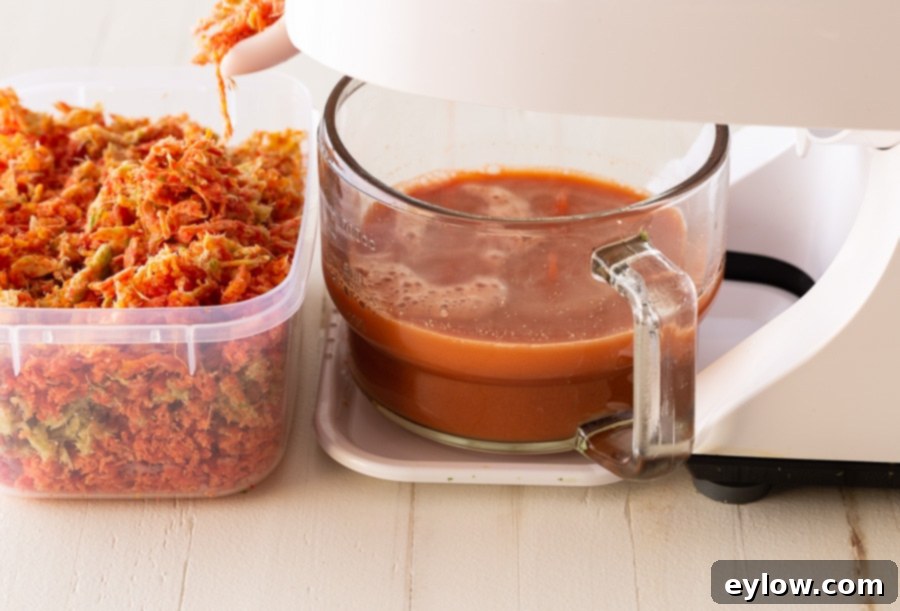
Understanding Why Juicing Is So Effective
The remarkable efficacy of juicing stems from several key factors. To produce a single glass of fresh juice, you typically need 1-2 pounds of raw produce. This means that by simply drinking a juice, you are consuming a far greater quantity of fruits and vegetables than you could realistically eat in one sitting. This concentrated intake ensures a massive flood of nutrients into your system.
Furthermore, because juices are raw and unheated, they are considered “living food.” This means they retain powerful enzymes that are often destroyed during cooking or processing. As the Cleveland Clinic notes, enzymes are the body’s essential “construction workers,” acting as catalysts that speed up countless biochemical reactions. They are fundamentally important for maintaining optimal health, aiding in everything from digestion to nutrient absorption and cellular repair. Raw, fresh juices deliver these vital enzymes in abundance, making them exceptionally bioavailable.
Beyond enzymes, consuming fresh raw juice saturates your body with a concentrated array of vitamins, minerals, and phytonutrients. Phytonutrients are special plant compounds that go beyond basic nutrition, actively contributing to disease prevention and overall health enhancement. They possess antioxidant, anti-inflammatory, and immune-boosting properties, which are delivered directly to your cells with minimal digestive effort when consumed in juice form. This rapid assimilation means your body can immediately put these powerful compounds to work.
Choosing the Best Vegetables and Fruits for Juicing
The key to making delicious and highly nutritious juices lies in selecting a diverse range of fresh, high-quality produce. Here’s a breakdown of excellent choices:
- Green Vegetables: These form the foundation of many healthy juices. Include ingredients such as celery (excellent for hydration and electrolytes), cucumber (very hydrating and mild), fennel (adds a unique flavor and digestive benefits), wheatgrass (a powerhouse of nutrients), and cabbage (surprisingly sweet and packed with vitamins), spinach (rich in iron and vitamin K), broccoli (a cruciferous champion), and bok choy.
- Green Leafy Vegetables: Essential for a nutrient-dense green juice. Options include kale (a cruciferous vegetable loaded with vitamins A, C, and K), spinach (versatile and mild), Swiss chard (offers a slightly earthy flavor), dandelion greens (known for their detoxifying properties, but start with small amounts due to bitterness), collard greens, and Romaine lettuce.
- Colorful Root and Other Vegetables: These add vibrant color and a different spectrum of nutrients. Carrots (rich in beta-carotene) and beets (great for circulation and detoxification) are popular choices. You can even juice carrot tops, though they can be bitter, so use sparingly at first. Don’t forget red bell peppers, which are an excellent source of vitamin C.
- Low-Sugar Fruits: To add natural sweetness and balance flavors without excess sugar, opt for tart green Granny Smith apples, pears, kiwis, grapefruit, and citrus like lemon and limes (which contain beneficial d-limonene). If you prefer a slightly sweeter apple and resulting juice, a Fuji apple is another good choice.
- Herbs and Spices: These add incredible flavor and potent medicinal properties. Fresh ginger root (anti-inflammatory and digestive aid), turmeric root (powerful anti-inflammatory), parsley (diuretic and rich in vitamins), cilantro (a fantastic natural detoxifier), dill, and mint (can be quite strong, so start with a small amount) are all excellent additions.
- Melons: Cantaloupe, honeydew, and watermelon can be juiced for a refreshing drink, but be mindful that they are higher in natural sugars. If you are diabetic, managing blood sugar, or focused on weight loss, it’s best to minimize or avoid juicing melons. If you do juice them, consider including the inner rind for additional nutrients.
Minimize or Eliminate High-Sugar Fruits: It’s generally best to limit fruits like pineapple, mangoes, and oranges in your juices due to their high sugar content. Many people are surprised to learn that a glass of orange juice can contain almost as much sugar as a soda.
Important Health Note: If you have specific health concerns, are on medications (especially blood thinners), or take certain supplements, always consult with your healthcare provider regarding any ingredient limitations before incorporating new ingredients into your juicing routine.
What about berries? Berries, while incredibly healthy, are generally better suited for smoothies. Their small seeds and pulp often don’t juice efficiently, leaving much of their valuable fiber and bulk in the pulp. Given the cost and availability of fresh berries, it’s often more economical and beneficial to enjoy them whole in dishes or blended into smoothies, like this blueberry green smoothie, a strawberry banana smoothie, or a chocolate blueberry smoothie.
Finally, always prioritize quality. Buy organic produce whenever possible to minimize pesticide exposure. If buying all organic isn’t feasible, consult the Environmental Working Group’s Dirty Dozen list to identify produce with the highest pesticide residues, and prioritize organic options for those items. High-quality, fresh produce is fundamental for high-quality, healthy juice.
Chef’s Tip: For a delightful summer juice without needing a juicer, try preparing this refreshing Mexican watermelon water with lime. It’s wonderfully hydrating and bursting with flavor. If you do own a juicer, you’ll love this crisp watermelon cucumber juice!
The Role of Fiber in Juicing
In simple terms, no, most fresh juices do not retain significant amounts of dietary fiber. The juicing process, particularly with centrifugal or masticating juicers, effectively separates the liquid (juice) from the insoluble fiber (pulp). This fiber removal is precisely what allows for the fast and easy assimilation of nutrients by your body. Think of juices as being “pre-digested”; the juicer does the heavy lifting, saving your digestive system the energy it typically expends to break down whole foods. This means your body can rapidly absorb the vitamins, minerals, and enzymes.
However, it is crucial to reiterate that fiber remains a critical component of a healthy, balanced diet. This is why it’s essential to continue eating your whole fruits and vegetables regularly and not solely rely on juicing. Juicing should be viewed as a powerful nutritional supplement that works in addition to your whole food intake, providing a concentrated boost of micronutrients that complement the fiber and macronutrients from your meals.
The exact amount of fiber removed can vary slightly depending on the type of juicer used. Some masticating juicers might leave a tiny amount of fine pulp, which you can either consume for a bit of extra fiber or strain through a fine sieve for a smoother, fiber-free juice. The primary benefit of minimal fiber in juice is that it allows for almost immediate absorption of nutrients into the bloodstream, giving your digestive system a beneficial break.
Addressing Common Criticisms of Juicing
Juicing, like many health practices, has its share of critics. A common argument often raised is the “loss of fiber” or the “high sugar content” of juices. What many of these articles and opinions fail to highlight is a fundamental principle of conscious juicing: it does not replace eating whole fruits and vegetables. Instead, juicing serves as a powerful, healthy supplement to a diet that already includes plenty of whole fruits and vegetables.
We need both fiber from whole foods for digestive health and satiety, and the concentrated, easily absorbed micronutrients that fresh juices provide. When approached correctly, juicing is not about replacing meals or fiber entirely; it’s about optimizing nutrient intake. Concerns about sugar content can also be mitigated by focusing on vegetable-heavy juices and low-sugar fruits, making it a valuable tool in a balanced diet rather than a problematic one.
Is Juicing Suitable for Everyone?
The answer to whether juicing is for everyone is nuanced and depends on individual health circumstances. Generally, almost everyone can benefit from incorporating vegetable juices into their diet. However, certain individuals need to exercise caution and seek professional medical advice.
If you have blood sugar issues, are diabetic, pre-diabetic, or are actively trying to lose weight, it is particularly important to stick with low-sugar vegetable juices and prioritize leafy greens. High-sugar fruits, even natural ones, can cause rapid blood sugar spikes.
Once again, it is paramount to consult with your healthcare provider about any existing health conditions, concerns, or potential ingredient limitations. This is especially true for green leafy vegetables, which have a high vitamin K content. Ingredients like kale, collard greens, broccoli, spinach, cabbage, and lettuce are rich in vitamin K (distinct from potassium).
Individuals on blood-thinning medications (such as Warfarin) must consult their doctor before significantly changing their diet or consuming green vegetable juices high in vitamin K, as it can interfere with medication efficacy.
Another consideration is for those concerned about oxalate levels, particularly if prone to kidney stones. Juices containing spinach, beet greens, beets, and chard are known to have relatively high oxalate levels. For more detailed information on this topic, refer to this article on oxalates. Always check with your healthcare provider for personalized limitations and recommendations.

Can Juices Replace Meals?
The use of juice as a meal replacement is a common question, particularly for those with specific goals like weight loss, a gentle detox, or a “spring cleaning” for the body. In these contexts, yes, juicing *can* be used as a meal replacement. However, it’s vital to do so thoughtfully and understand the implications.
When replacing a meal with juice, keep in mind that you might be missing out on other crucial macronutrients, such as protein and healthy fats, which are essential for satiety and sustained energy. While vegetable juices are incredibly nutrient-dense, they typically don’t provide a complete nutritional profile for a full meal.
Many individuals find that juicing provides a significant energy boost, which can effectively curb hunger and help them feel satisfied, even without solid food. Sometimes, the desire to eat is also a mental or social cue. Juicing can help shift this mindset, especially if your goal is short-term.
If you practice intermittent fasting, a fresh juice can be an excellent tool to help you extend your non-eating window in the morning or evening. It provides a burst of nutrients without triggering a significant digestive response, helping you adhere to your fasting schedule while still feeling nourished.
Advance Preparation and Storage of Juices
How far in advance you can prepare your juices while retaining maximum nutritional value largely depends on the type and quality of your juicer. Generally, for optimal health benefits and flavor, most juices are best consumed within 15-20 minutes of being made. This is when enzyme activity and vitamin content are at their peak.
However, modern slow-press or masticating juicers are designed to minimize oxidation, allowing for longer storage times with minimal nutrient loss. If you’re juicing ahead for meal prepping or simply to make your daily routine easier, storing juice in an airtight bottle within 24 hours is generally considered acceptable. Always consult your juicer manufacturer’s guide for specific recommendations tailored to your model.
For maximum health benefits, especially when using a high-quality juicer, it’s often recommended to drink your fresh juice on an empty stomach and wait about 20 minutes before consuming other foods. This allows for rapid absorption without competition from other digestive processes.
The ability to juice in advance with minimal nutritional degradation is one of the features I particularly appreciate about my juicer model. It allows me to make batches of juice for up to 3 days at a time without significant loss of enzyme or vitamin content. For many, this convenience factor, along with the health benefits, helps to justify the initial investment in a quality machine.
Optimal Juice Storage Practices
Proper storage is crucial for preserving the freshness, flavor, and nutritional integrity of your homemade juices. The best way to store fresh juice is in glass bottles with tight-fitting, air-sealed caps. Glass is preferred over plastic as it doesn’t leach chemicals and better maintains the juice’s flavor. You can choose from various sizes:
- 12-ounce glass bottles
- 16-ounce glass bottles
- 18-ounce glass bottles
The size you choose will depend on your daily consumption goals. A critical tip for storage is to fill the bottle completely to the very top, leaving no air gap. Oxygen is the enemy of fresh juice, as it causes oxidation and nutrient degradation. If you find yourself a little short on juice to fill a bottle, simply top it off with filtered water to eliminate any air space.
One more crucial detail: ensure your refrigerator is set to an adequately cold temperature. The FDA recommends keeping your refrigerator at 41°F (5°C) or below. For optimal preservation of fresh juices and other perishables, I personally recommend maintaining your refrigerator temperature between 34°F – 37°F (1°C – 3°C).
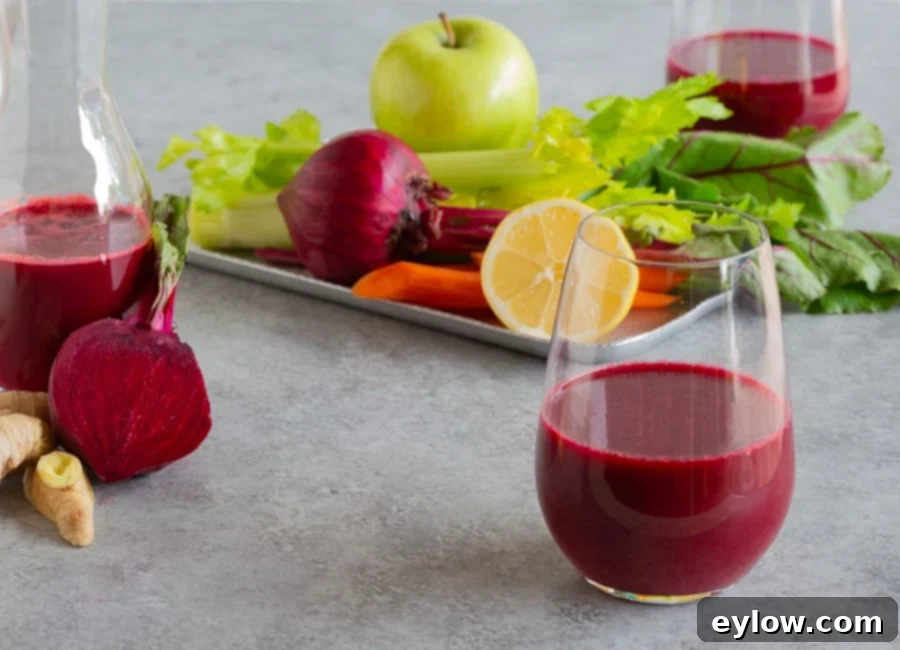
Creative Uses for Leftover Juice Pulp
One of the most common questions after juicing is what to do with the leftover pulp. While I haven’t yet perfected my own specific recipes for pulp utilization, it’s a fantastic resource that can reduce waste and add valuable fiber back into other dishes. I am actively working on developing recipes to incorporate this “wonderful fiber” into various culinary creations. Imagine adding it to burger patties or meatballs for added moisture and nutrients, blending it into smoothies for extra body, or using it as a base for flavorful dips. Pulp is also an excellent ingredient for making rich, homemade vegetable broth.
For a wealth of inspiration and creative ideas, I highly recommend checking out this page on Pinterest dedicated to juice pulp recipes. While you’re there, be sure to explore my own pins and consider following me on Pinterest for more health-focused culinary tips and ideas. Most often, if I’m not using it immediately, my pulp goes straight into the compost, enriching my garden.
Key Questions When Buying a Juicer
Investing in a juicer is a personal decision that requires some thoughtful consideration to ensure you choose the best machine for your lifestyle and needs. Before making a purchase, ask yourself the following questions:
- How many people will you be juicing for? Are you making juice just for yourself, for two, or for an entire family? This will influence the capacity and type of juicer you need.
- Will you juice every day? If juicing is a daily habit, durability, ease of cleaning, and efficiency will be paramount.
- How big is your kitchen and work area? Juicers can vary significantly in size. Consider your counter space and storage availability.
- Where will you store your juicer? Will it be a permanent fixture on your countertop, or will you need to tuck it away after each use?
- What is your juicer budget? Juicers range from economical options to high-end professional models. Establish a realistic budget.
- Would you prioritize speed or nutritional value? Some juicers are faster but may sacrifice some nutrient retention due to heat, while others are slower but extract more nutrients.
Chef’s Tip: To streamline your juicing process and make it a more manageable daily habit, adopt a strategy of preparing your produce in advance. When you return home from the grocery store, wash all your juicing ingredients at once. Once clean and dry, store them in airtight containers in your refrigerator. This simple step significantly reduces prep time, making daily juicing much faster and more enjoyable.
Finding the Best Juicer for Your Needs
Choosing the “best” juicer is a highly personal decision, given the wide variety of models available on the market. From my extensive experience, I can share some insights to help you navigate this choice. There are primarily two main types of electric juicers to consider: centrifugal juicers and masticating juicers. You might also encounter twin gear juicers, which are a specialized form of masticating juicer.
For the highest quality juices and maximum nutrient preservation, I strongly recommend a slow, cold-press, masticating juicer. These machines work by “chewing” or grinding the produce slowly, similar to how your teeth would, extracting every bit of beautiful, nutrient-rich juice. This slow process generates minimal heat, which helps preserve delicate enzymes and vitamins that can be destroyed by the higher heat of centrifugal models. While masticating juicers tend to be a bit slower and more expensive upfront, they yield more juice from your produce, potentially saving you money on ingredients in the long run.
My first juicer was a popular centrifugal brand. Many people love them for their speed and affordability, but I eventually found myself less than satisfied with its performance and nutrient retention.
Ultimately, I transitioned to slow, cold-pressed juicers and have been incredibly happy with their performance. I encourage you to explore reputable companies like Tribest as you conduct your own research into different brands. These juicers are particularly excellent for processing fibrous ingredients like celery stalks, ensuring you get a high-quality celery juice.
Before purchasing, always read reviews, check ratings, and confirm that the company offers reliable customer service. I once nearly invested in another major juicer brand until I discovered their customer service was notoriously poor. A good warranty period is also a vital consideration.
Another crucial tip: opt for a well-established juicing brand. The market is saturated with cheaper competitors that often compromise on juice quality, machine durability, and overall performance.
For those looking for a capable and reliable option, this mid-range juicer performs admirably. If you’re seeking a more economical and compact choice, the Shine Multi-Batch Juicer is an excellent entry-level option. For dedicated juicers or families who juice daily, consider the Greenstar Elite juicer. It’s a fantastic, high-performing machine (and my personal main juicer), though it represents a more significant investment. Do shop around, as Amazon doesn’t always have the best price for this model.
And if your budget allows for a top-of-the-line option, Tribest also offers their advanced Greenstar 5 juicer. For further assistance in making your choice, this informative article on the pros and cons of different juicer types can be incredibly helpful.
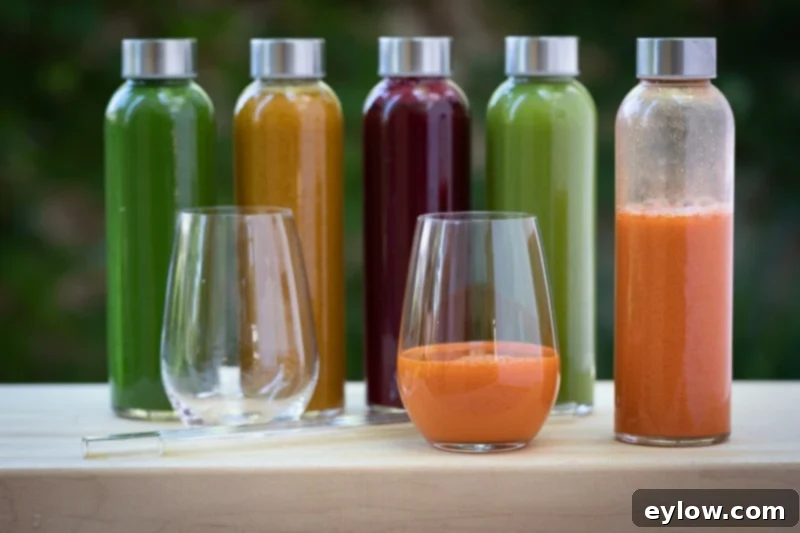
Getting Started: Juicing for Beginners
Embarking on your juicing journey as a beginner is an exciting step towards better health. Here’s a simple guide to get you started:
- Choose Your Juicer: First, make your juicer selection based on your budget, needs, and the information discussed above.
- Read the Manual: Thoroughly familiarize yourself with your juicer’s manual. Understand how to assemble, operate, and clean it properly.
- Start Simple: Begin with basic juices using just a few common and mild ingredients. This allows you to get comfortable with the process and discover what flavors you enjoy most.
- Vary Your Ingredients: Once you gain confidence and know your taste preferences, start experimenting. Varying your ingredients is crucial to ensure you receive a wide spectrum of nutrients and prevent boredom.
Excellent starting ingredients include celery, cucumber, carrots, a tart green apple (like Granny Smith), half a lemon or a whole one (peeled), and a small knob of fresh ginger. These are generally palatable and easy to juice. From there, gradually branch out to incorporate leafy greens, beets, various herbs, and more adventurous ingredients. Don’t hesitate to try different recipes and combinations until you find your favorite, delicious blends.
Chef’s Tip: While organic produce may have a higher price point, it remains the superior choice for juicing. This minimizes your intake of pesticides and ensures the purest nutrients. Furthermore, always make it a habit to use a good produce wash, like the one I’ve trusted for years, to thoroughly clean your fruits and vegetables before juicing.
Juicing with a Blender: A Viable Alternative?
If you’re eager to start juicing but can’t immediately afford a dedicated juicer, using a blender can be a temporary and viable way to begin your journey while you save up for a proper machine. It’s important to understand, however, that a blender creates a smoothie-like consistency that retains all the fiber, rather than a true juice where the fiber is separated. Therefore, the nutritional yield and absorption profile will differ. Nevertheless, it’s a great stepping stone.
Juicers are more economical than many people realize, with entry-level models starting as low as around $100. So, before you dismiss the idea due to cost, take the time to shop around for affordable options.
You might also find excellent deals at garage sales or on local online sales groups. Many people start juicing with good intentions but struggle to stick with the habit and end up selling their machines. Just be sure to test it to confirm it’s in working order.
To “juice” with a blender: first, chop your vegetables and fruits into small pieces. Add them to your blender with a minimal amount of water – just enough to help the blades process the ingredients smoothly. Blend until the mixture is as smooth as possible. Finally, strain the pulpy mixture through a nut milk bag or a very fine mesh strainer to separate the liquid from the pulp. This will give you a result closer to a traditional juice, though it will still likely be thicker than a true cold-pressed juice.
Delicious Juice Recipes to Try
Curious about the buzz around celery juice? This article offers some insightful “food for thought” on the potential benefits of celery juice. Whether it’s the vibrant notes of beet juice or the earthy sweetness of carrot juice, there’s a world of delicious and healthy concoctions waiting for you. Get ready to experiment with these fantastic juice recipes!
- Green Juice with Cabbage and Celery
- Celery Cucumber Juice
- Beet Juice Recipe
- Carrot Ginger Juice Recipe
📖 Recipe: Simple Basic Green Juice

Simple Basic Green Juice
Sally Cameron
Pin Recipe
Equipment
-
preferably an electric juicer
Ingredients
- 2 ribs celery
- 2 Persian or mini cucumber or half a field or English cucumber
- ½ lemon
- ½ inch knob of fresh ginger
- handful fresh parsley or cilantro
Instructions
-
Wash produce well, prepare as outlined in the manufacturers handbook and process the vegetables for juice. Drink within 15-20 minutes for the best nutrition and quality, depending on your juicers capabilities.
